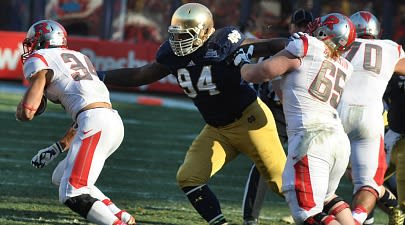Shoddy turf tarnishes Pinstripe Bowl

Yesterday's 2013 New Era Pinstripe Bowl at Yankee Stadium provided a unique setting for post season college football as it took place in the heart of New York City. It was a clear, sunny day that made for perfect football weather in December. However, down on the field it was a different story for Rutgers and Notre Dame.
From the opening kickoff, players were slipping and sliding on the turf in the baseball stadium.
Advertisement
"It wasn't the greatest surface, but you have to play the cards you were dealt," said Rutgers starting cornerback Anthony Cioffi. "We switched cleats for this surface and you just have to get all your cleats in the ground. It was a little different playing in those cleats. They felt a bit heavier."
For Cioffi and his fellow cornerbacks, the footing made things much tougher as the Rutgers defensive scheme had them routinely providing big cushions to prevent deep passes.
"We thought we'd be able to break on the balls a little better than maybe we did and that allows [Notre Dame] to continue some of those drives," said Rutgers head coach Kyle Flood.
Notre Dame cornerback Tommy Rees took advantage of the huge cushions, particularly since the RU cornerbacks would immediately begin backpedaling when the ball was snapped. That made shorter passing routes very easy to complete and nearly impossible to defend.
"The footing was very bad out there," said Rutgers starting cornerback Gareef Glashen. "You had to be careful with your breaks and things like that."
The end result was a 3-19-yard passing day for Notre Dame quarterback Tommy Rees and was very similar to the way other teams decimated Rutgers with shorter passes all season long.
The terrible turf actually helped Rutgers by causing quite a few Notre Dame players to slip and negate would-be gains. Early on in the first quarter, the turf took down Notre Dame running back Tarean Folston on the four-yard line on a play that probably would have went for a touchdown on an adequate field.
The favor was returned on the next drive as Chas Dodd slipped in the open field for a two-yard gain with a whole lot of room to run in the Notre Dame redzone. Consequently, both drives resulted in field goals.
"We knew that the surface was going to be a little slippery, and we were prepared for that with our cleats and how we were doing things offensively as far as running routes and stuff," Dodd said. "We've got to be able to do a better job. You can't necessarily control it, but you can adapt to it, and we have to do a better job because we did have a few slips."
The slipping and sliding continued as both teams felt the effects of the shoddy turf. Counting the total takedowns would have been no easy task as there is a good chance the turf would have led both teams in tackles.
It even changed some of what the teams did on offense.
"You had to know the field and when I would get to one side of the field, I would have to slow down on my cuts and stuff so it did kind of change the way I played," said Rutgers running back Paul James.
Both teams were hindered by the playing surface through four quarters although Rutgers can hardly blame the 29-16 loss on shoddy turf. However, the biggest loss might be for the Pinstripe Bowl as it failed to provide a playing field where both teams could perform at their very best.